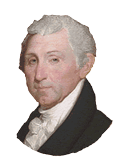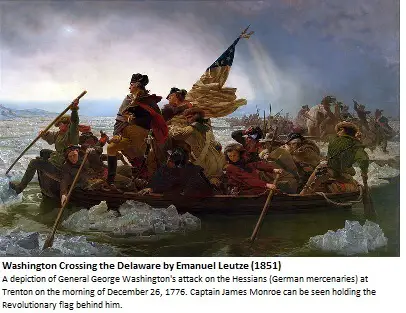Fifth President of the United States
| Term: | 1817-1825 |
| Party: | Democratic-Republican |
| Full name: | James Monroe |
| Born: | April 28, 1758 |
| Birthplace: | Westmoreland County, Virginia |
| Nicknames: | The Era of Good Feelings President The Last of the Crooked Hats The Last Cocked Hat |
| Education: | Campbelltown Academy A year at the College of William and Mary Apprenticed law under Thomas Jefferson |
| Vocation: | Soldier, Lawyer |
| Height: | 6 ft 0 in (183 cm ) |
| Hair Color: | Brown |
| Eye Color: | Hazel Brown |
| Religion: | Episcopalian |
| Spouse: | Elizabeth Kortright Monroe |
| Children: | Eliza Kortright (1786–1835) James Spence (1799–1801) Maria Hester (1803–1850) |
| Date of death: | July 4, 1831 |
| Place of death: | New York, New York |
Facts About James Monroe
James Monroe, the last in the line of the ‘Founding Fathers President‘ and the Virginia Dynasty, is viewed by many as the first real executive to be elected into the White House. Devoid of the military grandeur of Washington, the command of the law of Adams, the genius of Jefferson, and the philosophical brilliance of Madison, Monroe’s eight years in the White House marked a transformation in American politics, tilting the balance of power from the executive to the legislative branch. Monroe’s humility, integrity, and respect for the ideals of the Constitution shaped the dynamics of the relationship between the presidency and Congress and the separation of powers that have lasted to this day.
Character of James Monroe “To be plain, there is often in his manner an inartificial and even an awkward simplicity, which, while it provokes the smile of a more polished person, forces him to the opinion, that Mr. Monroe is a man of a most sincere and artless soul.Nature has given him a mind neither rapid nor rich; and, therefore, he cannot shine on a subject which is entirely new to him. But, to compensate him for this, he is endued with a spirit of restless and generous emulation, a judgment solid, strong and clear, and a habit of application, which no difficulties can shake, no labors tire. With these aids, simply, he has qualified himself for the first honors of this country; and presents a happiest illustration of the truth of the maxim, fortunes faber.For his emulation has urged him to perpetual and unremitting inquiry his patient and unwearied industry has concentrated before him all the lights which others have thrown on the subjects of his consideration, together with all those which his own mind, by repeated efforts, is enabled to strike ; while he’s sober, steady and faithful judgment has saved him from the common error of more quick and brilliant geniuses the too hasty adoption of specious, but false conclusions. These qualities render him a safe and able counselor.” “To be plain, there is often in his manner an inartificial and even an awkward simplicity, which, while it provokes the smile of a more polished person, forces him to the opinion, that Mr. Monroe is a man of a most sincere and artless soul.Nature has given him a mind neither rapid nor rich; and, therefore, he cannot shine on a subject which is entirely new to him. But, to compensate him for this, he is endued with a spirit of restless and generous emulation, a judgment solid, strong and clear, and a habit of application, which no difficulties can shake, no labors tire. With these aids, simply, he has qualified himself for the first honors of this country; and presents a happiest illustration of the truth of the maxim, fortunes faber.For his emulation has urged him to perpetual and unremitting inquiry his patient and unwearied industry has concentrated before him all the lights which others have thrown on the subjects of his consideration, together with all those which his own mind, by repeated efforts, is enabled to strike ; while he’s sober, steady and faithful judgment has saved him from the common error of more quick and brilliant geniuses the too hasty adoption of specious, but false conclusions. These qualities render him a safe and able counselor.”William Wirt (1772-1834), 9th U.S. Attorney General |
His story began in a plantation deep in the Northern Neck of Virginia, near what is known today as Monroe’s Creek, where he was born into the middle-class family of a plantation owner and part-time carpenter Spence Monroe and Elizabeth Jones Monroe. Monroe, the second oldest of five siblings (older sister Elizabeth, and brothers Spence Jr., Andrew and Joseph), spent his first eleven years of live playing in the marshes, saltwater creeks and coves of the land, and was homeschooled by his mother.
At the age of eleven, at the intervention and financial assistance of his maternal uncle, the Hon. Joseph Jones, young Monroe was sent to Campbelltown Academy in in Washington Parish in Westmoreland County, which at the time was the finest school in Virginia. He excelled there, showing particular flair in Latin and Mathematics.
At the age of 16, Monroe was informed of the death of his father Spence, and returned home promptly to manage the family’s now 1,100 acres estate. However, his uncle successfully persuaded him to continue his education and promptly enrolled him in the College of William and Mary.
His time there coincided with the advent of the American Revolution, and the young man, a descendant of King Edward III of England and whose great-grandfather fought in the English Civil War (1642–1651), left college after barely a year to join the fledgling Virginia militia.
The 17-year-old’s courage and leadership quickly saw him promoted to Lieutenant, and he was part of several of the bloodiest battles of the Revolution. His bravery in the Battle of Trenton on Christmas Day of 1776, in particular, elevated Monroe to the role of hero in the eyes of his men, as well as a promotion to Captain. During the battle, the army of General George Washington was pinned by about 30,000 German mercenaries at the banks of Delaware River, even as a steady barrage of cannon fires from across the river threatened to decimate the stationary American forces.
 Monroe led his men under the cover of darkness to attack the unit, and successfully held the cannons until reinforcements arrived. However, Monroe was shot on his left shoulder during the assault and were it not for the quick actions of the army doctors, he could’ve lost his hand or even died. In the famous Emanuel Leutz’s 1851 painting, “Washington Crossing the Delaware”, Monroe is seen standing behind General Washington on a boat, holding the Revolutionary’s flag.
Monroe led his men under the cover of darkness to attack the unit, and successfully held the cannons until reinforcements arrived. However, Monroe was shot on his left shoulder during the assault and were it not for the quick actions of the army doctors, he could’ve lost his hand or even died. In the famous Emanuel Leutz’s 1851 painting, “Washington Crossing the Delaware”, Monroe is seen standing behind General Washington on a boat, holding the Revolutionary’s flag.
After his recovery three months later, Captain Monroe tried to form a new militia regiment in Virginia, but the absence of benefactors and low number of volunteers put paid to the plan. Instead, he traveled to the capital and sought out a highly spoken of and very respectable red-haired genius, Thomas Jefferson, with the intention of studying law under him. Monroe’s fame and humility worked in his favor, and Jefferson took him under his wings. Jefferson also introduced him to another one of his protégés, a certain James Madison, and in the process, unknowingly creating quite possibly the most powerful political triumvirate in American history, consisting of the 3rd, 4th, and 5th Presidents of the United States.
Three years later, the still only 24-year old Monroe began his political career by successfully contesting for a seat in the Virginia legislature. His leadership ability, meticulous attention to detail and adherence to the law quickly propelled him to a leadership position in the House of Burgesses, culminating with his appointment as the Virginia member of the Congress of the Confederation. Two years later, the House of Burgesses appointed him to the newly established U.S. Senate. He quickly established his authority in the Senate, and working in tandem with Madison, who was the fulcrum of anti-Federalist forces in the House of Representatives, the two men became the lynchpin of the new Jeffersonian faction.
The leader of the Federalist faction, Alexander Hamilton, successfully lobbied President George Washington to appoint Monroe as the Minister to France, diluting the burgeoning influence of Thomas Jefferson in Congress. Monroe served there for two years, before returning in 1796, where he faced strong resistance from the Federalist forces in his attempt to reenter Congress. However, he re-established himself in Virginia, and in 1799, was appointed Governor, serving three terms in office.
The election of friend and mentor Thomas Jefferson to the White House signaled a reversal in political fortunes for him. In 1803, Jefferson appointed him as Minister to the United Kingdom, serving for five years before returning to Virginia. Monroe returned to public service in 1811 when he was appointed as the Secretary of State under the Madison administration. He also briefly served as Secretary of War, after the resignation of the disgraced John Armstrong, Jr. following the War of 1812.
When Americans went to vote in 1816, there was hardly any doubt over the identity of their next president – senator, governor, diplomat and war hero James Monroe. The Federalists, after a twenty-year battle against the Jeffersonians, did not even name a candidate against Monroe, so certain were they of his victory. Monroe would eventually win 16 of the 19 states and 184 out of 217 Electoral College votes in a matchup against self-appointed Federalist candidate, Rufus King.
He was sworn into office on March 4, 1817, and was re-elected for a second term in 1821.
